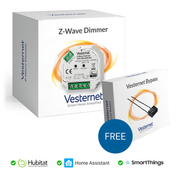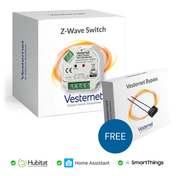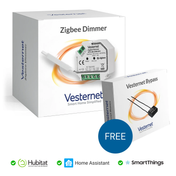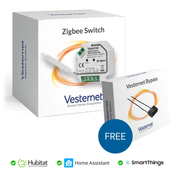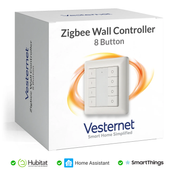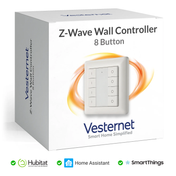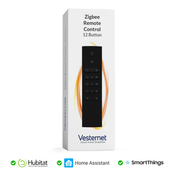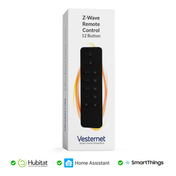Choosing a smart home hub can be a challenging decision, especially when two highly capable devices from the same brand are vying for your attention.
This scenario is particularly apt when considering the Fibaro Home Center 3 and its newly released sibling, the Fibaro Home Center 3 Lite.
To guide you through this decision, we've taken a closer look at the specifications and features of both devices, enabling you to determine which of these automation hubs best aligns with your needs.
Fibaro Home Center 3

The Fibaro Home Center 3 is a premium home automation hub with an impressive array of features. It has the capacity to handle up to 240 devices, making it perfect for larger homes or intricate automation systems. With a powerful Quad-Core ARM Cortex A53 1,2GHz processor, 2 GB of RAM, and 8 GB of memory, the HC3 ensures smooth operation.
You can control your smart home system through various platforms such as mobile apps, online portals, voice commands, and also set up unlimited scenes using unlimited Quick Apps and plugins. Additionally, the HC3 integrates effortlessly with Satel alarm systems and an unlimited number of IP cameras.
Fibaro Home Center 3 Lite

On the other hand, the Fibaro Home Center 3 Lite is designed for smaller homes and more basic automation needs, but still packs a punch. Underpinned by Z-Wave 700 technology, it ensures high data security while being simple and swift to set up. This unit supports over 2000 smart devices, giving you plenty of options to customize your home automation system. You can control your system via a mobile app, an online portal, or voice commands, allowing a seamless operation of your smart home.
What's the difference between the Fibaro Home Center 3 and the Fibaro Home Center 3 Lite?
While both Home Center 3 and Home Center 3 Lite offer the convenience of home automation, their capacities and targeted user bases are where the key differences lie. The Home Center 3 is a robust solution designed for larger homes, with support for up to 240 devices and seamless integration with other security systems like Satel. Meanwhile, the Home Center 3 Lite, while supporting a wider variety of devices (over 2000), is aimed at smaller households with simpler automation requirements.
Pros & Cons
Fibaro Home Center 3
Pros:
- Ideal for larger homes or complex systems
- Can manage up to 240 devices
- Seamless integration with Satel alarm systems and IP cameras
Cons
- May be overkill for smaller residences or simpler systems
- More expensive than the Lite version
Fibaro Home Center 3 Lite
Pros
- Great for smaller homes or simpler automation needs
- Supports over 2000 smart devices
- More affordable than the HC3
Cons
- Limited to 40 devices per system
- Does not support integration with Satel alarm systems or IP cameras
Breaking Down the Technical Specifications
Looking at the specifications table, you may wonder about its contents and why they are important. This guide will clarify everything for you, assisting you in comparing the Fibaro Home Center 3 and Lite.
Software features
Remote and Mobile Access
You can control your smart home from anywhere using your smartphone, tablet, or computer. The Fibaro Widgets create shortcut buttons on Android and iOS devices, providing quick access to frequently used scenes. You can even sync the system to your Android smartwatch with Android Wear.
Voice Assistant
If you use Voice Control, you'll appreciate the ability to control your Fibaro system using Amazon Alexa or Google Assistant. Siri voice control is also supported, but currently, it's only through Siri "shortcuts".
VOIP (Voice Over IP)
Both the Fibaro Home Center 3 and Lite support VOIP, which lets you communicate over an IP network (Internet or home network). This feature is useful for creating an intercom system or access control (door or gate).
Master Gateway
If your home automation system includes more than 230 devices, you can connect multiple Home Center hubs. The HC3 can function as both Master and Slave, while the HC3 Lite can only be a Slave, meaning you'll need an HC2 or HC3.
Geolocation
The Geolocation feature uses your smartphone's location service to activate scenes when you're near your home. For instance, when you're three miles from home, the system can turn on the outside light.
Plug-ins
There's a wide range of Plug-ins available from Fibaro and third-party developers, including Philips Hue, Sonos, IFTTT, and Yamaha. These Plug-ins allow you to perform advanced actions without coding skills. The Home Center 3 Lite is limited to 5 plug-ins, while the Home Center 3 can run an unlimited number. However, running too many could affect the system’s performance.
Recovery and Backup
All Fibaro hubs create regular backups of previous software and configuration versions, making it easy to restore in case of problems. Both hubs backup locally and to the Fibaro cloud.
Scenes
Scenes are tasks that you want your Fibaro system to complete at a specific time, like warming your home, turning on the hallway light, and starting the kettle at 5:30 pm when you usually get home. The Fibaro Home Center Controllers provide three methods to create Scenes: Block Scenes, Magic Scenes, and LUA Scenes. With the Home Center 3 Lite, you can create up to 20 scenes, while the Home Center 3 allows unlimited scenes.
Block Scenes
These allow you to create fairly complex scenes using customizable blocks. You can establish multiple triggers and actions.
Magic Scenes
These are the simplest way to perform tasks, allowing only one trigger and one action.
LUA Scenes
These advanced scenes use the LUA programming language. You'll need some basic programming skills, but LUA Scenes allow you to do almost anything. These scenes are more advanced than the Block Editor.
You can also download other users’ Scenes from the Fibaro Marketplace, saving you time and allowing you to experiment with your system.
Fibaro quick apps
These virtual devices in the Fibaro Home Center Controller can control products using different networks. The Lite allows up to 10 Quick Apps, while the HC3 allows unlimited.
For instance, Quick Apps can control your AV equipment using your Wi-Fi/Ethernet network (IP Strings) and manage several scenes simultaneously.
The Fibaro Marketplace offers a great starting point to experiment with other users’ Quick Apps.
Scene and Device Control/Complex Logic (LUA)
As mentioned earlier, LUA is a robust programming language that can handle complex tasks.
Stat comparison table
| Features | Home Center 3 | Home Center 3 Lite |
|---|---|---|
| Application | ||
| Uses | Houses, Apartments | Smaller houses (up to 100 m2) and apartments |
| General Software | ||
| Remote Access | Yes | Yes |
| iOS App | Yes | Yes |
| Master Gateway | MASTER and SLAVE mode | SLAVE mode |
| Scene Control | ||
| Maximum Number of Scenes | Unlimited | Up to 20 |
| Home Automation Support | ||
| Z-Wave (868.4MHz) | Yes | Yes |
| ZigBee | Ready | No |
| Recommended No. of Z-Wave Devices | Up to 230 | Up to 40 |
| Hardware Features | ||
| Processor (CPU) | Quad-Core ARM Cortex A53 1.2GHz | Single-Core ARM Cortex A7 900 MHz |
| Memory (RAM) | 2GB | 512 MB |
| Dimensions (LxWxH) | 220 x 140 x 35mm | 110 x 178 x 31mm |
Conclusion
Your choice between the Fibaro Home Center 3 and Home Center 3 Lite will ultimately depend on your specific needs.
If you're looking to set up a complex system in a large home, the Fibaro Home Center 3's premium features and integration capabilities make it a worthy choice.
On the other hand, if you're new to home automation or have a smaller residence, the Home Center 3 Lite's affordability and simplicity make it an appealing option.
Buy the Fibaro Home Center 3 here here and the Home Center 3 Lite here.

